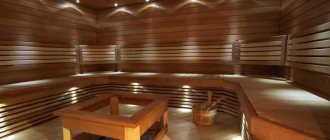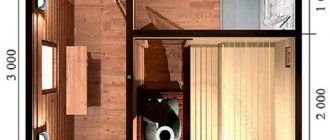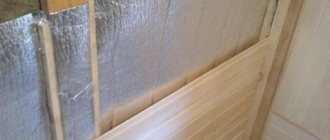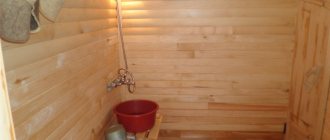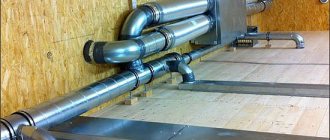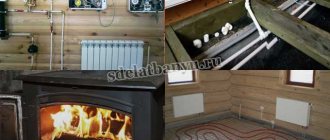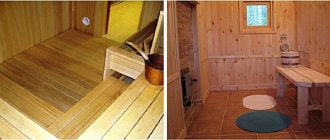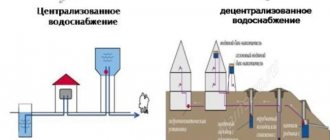- Attic
The design of the steam room is such that it maintains a constant high temperature, and the air should be moist, saturated with water droplets. But in a closed room with such climatic conditions, mold will certainly grow, and combustion processes will also be disrupted due to the lack of oxygen, not to mention the fact that people inside will have nothing to breathe. Therefore, it is necessary to design ventilation in the bathhouse. We will talk about it in this article.
Is a ventilation system necessary?
When building a steam room, novice builders try to fit all slats and lamellas as tightly as possible, thereby ensuring the absence of temperature losses. This is true, but if you do not leave natural openings or artificially created outlets, then significant smoke is possible when the stove runs on wood or coal. Any fuel leaves traces of combustion. Carbon monoxide in high concentrations will lead to loss of consciousness and the possibility of death, especially if the people in the room are steamed, with unstable pressure, and dilated blood vessels.
Therefore, a ventilation system is required for the following tasks:
- creating the necessary microclimate;
- ventilation and drying of wood to prevent mold or mildew from occurring;
- removal of carbon dioxide, there are people in the steam room, so a constant supply of fresh air is necessary;
- promoting the combustion process, for which oxygen is important;
- eliminating unpleasant odors;
- preserving the slats and shelves in their original form.
Microclimate measurements in the steam room
Each steamer has individual requirements for temperature and humidity conditions. They are based on personal feelings. You can achieve the creation of certain parameters using instruments.
Thermometer for measuring temperature in a steam room
Measure the temperature in the steam room with an alcohol thermometer. Do not use a mercury thermometer. You can use an electric thermometer. The thermocouple is placed in the steam room, and the indicator is brought out into the dressing room or rest room.
Air humidity can be measured with a hygrometer. Based on the individual preferences of the steamer, you can use this device to set a certain mode.
The principle of operation of the ventilation system in the bathhouse
The entire ventilation network can be divided into natural, which is located in the walls, roof and foundation and is laid at the beginning of construction, and forced, which is activated only when using a steam room.
Both types work as follows: waste oxygen is displaced and the space is filled with fresh air. The flow has 2 ends - inflow and outflow, respectively, you need at least two holes located according to the rule: inlet hoods are lower than outflow hoods.
Another nuance of the operating principle is that all the gas is taken from where it goes. When there is a connection with the street, everything should go there. Likewise, if in the next room. When the inlet and outlet are at different temperature conditions, the formation of a flow will not work. However, it is recommended to supply/exhaust air from the street, since even in the waiting room it will be humid and insufficiently enriched with oxygen.
Methods for installing forced ventilation
It is not always possible to provide natural air exchange of acceptable intensity. Such ventilation does not work well both in bathhouses with a large number of rooms, and in those that have a common wall with the house or are built into it.
In such cases, they resort to a device for forced injection and/or release of air, artificially creating flows or forcing them to move faster. To do this, fans are built into the system - exhaust or supply.
Supply fan installed in the corresponding hole Source engvent.ru
See also: Catalog of companies that specialize in the construction of baths, ventilation and air conditioning equipment
Depending on the type of object, one of the following types of forced ventilation is used:
- supply and exhaust when both types of fans are used. A rather rare option in private baths, since they do not require high ventilation intensity;
- supply , with mechanical suction of air through the supply opening and increasing the pressure in the room, due to which the exhaust air is squeezed out into the hood. Its main drawback is the too active supply of cold air masses;
- exhaust , the operating principle of which is the opposite: a fan in the exhaust hole forcibly removes polluted air outside, creating a vacuum inside, forcing clean air from the street to fill the vacated volume, entering the supply hole.
If you choose how to properly make a hood in a bathhouse, then preference should be given to the last option as the most optimal.
Fan on the exhaust vent Source stroi-remontirui.ru
Fan selection
Any mechanisms operating in a bathhouse must withstand difficult operating conditions: high humidity, heat, frequent temperature changes. Therefore, the fan is selected primarily based on these requirements.
Proper ventilation in the sauna steam room
When designing a building, you immediately need to calculate where the shafts will be located and what diameter they will be. And the holes themselves and the dampers are placed on them directly after facing with lamellas. There are 4 types:
| View | Inflow (mm) | Hood (mm) |
| Finnish | 130 | 100 |
| Swedish | 100 | 80 |
| Russian | 100 | 100 |
The most common solution, unfortunately, is the absence of a ventilation system.
The size of the holes directly depends on what you want to get in the end: a Russian steam room or a sauna.
Let's look at an example of a calculation. If the steam room is 3 m by 1.5 m with a height of 2.5 m, that is, approximately 10-11 m3, you need a 20 kW stove. In this case, it is better to use a natural type of air exchange - with an air inlet 10 cm from the floor at a distance of 30 cm from the stove, and a diagonal outlet under the shelves at a height of 80 cm.
In this case, it is necessary to take into account: from under the lining the valve operates in the closed or open position only. It should not be adjusted, as it is made airtight, otherwise the steam will escape. Both outlets do not need to have the same radius, but if more efficient and faster circulation is needed, the first one can be made a little larger or two valves installed in different places. It is strictly forbidden to make it smaller than the supply unit. This is against safety regulations.
It is imperative to install valves on the ventilation holes, which will seal hermetically to the opening when closed - at the time of kindling and heating the steam room. In winter, these doors will be half closed, because the greater the temperature difference, the more air circulates. The hoods should be at the top, and the inflow should be at the bottom. This will allow oxygen to ventilate naturally. The most popular option today: 100 mm – inflow, 80 mm – exhaust.
The "grandfather's" method
There is also an interesting method of ventilating a bathhouse, handed down from our ancestors, which EsKor, a member of our portal, saw in the bathhouse of “one gray-haired grandfather.” In this bathhouse, the only specially made means of ventilation was an vent a meter from the floor, under the shelf. What is the point of such an outlet? It turned out that the gray-haired grandfather “refreshed” the air in the steam room in almost the same way as Nomad, only he prepared a bucket of ice water in advance and poured it onto the shelf either a moment before or immediately after a shock dose of water was charged into the heater.
EsKor
The grandfather explained that the cold water that falls onto the floor from the shelf pulls the steam down, and it takes stale air with it and flies away into the vent. There is no mysticism, physics explains this matter well.
Cold water cools the steam, condensation occurs, the decrease in pressure causes an increased flow of air above the steam layer, and the steam literally falls from the ceiling.
It is clear that this method is not suitable for dry-air baths and steam rooms with a solid floor and no drain.
Types of ventilation
Some 5 years ago no one talked about the ventilation system in the bathhouse; moreover, many argued that it was not needed at all. A window is enough. Times have changed, and now everyone is in favor of ventilation in the bathhouse. At the moment there is a forced and natural look. The chosen option depends on the area of the steam room, climatic conditions, and also on the wishes of the owner.
Natural
It works on the difference in temperature and atmospheric pressure differences inside and outside. This is a very effective and long-used method. There is a nuance for arranging such circulation in the steam room. In the heated room itself, due to the natural laws of physics, it is difficult to provide uniform heat. Typically, the higher you go, the hotter it is, and the floors can stay quite cold. The builder’s task is to think through a system so that a draft does not blow through the feet, and unbearable heat does not accumulate on the ceiling. This can be achieved by dividing the flows into two or three hoods.
Forced
Implemented by electronic control, which depends on the temperature. You can turn the fresh air supply on and off as desired. You can control using a digital device how many degrees should be maintained throughout the entire time of the procedure, as well as what humidity the system needs to be adjusted to.
Typically, such complexes are created for commercial purposes, so they are much more expensive than elements for natural outflow, and installation can only be carried out by specialists.
One of the main disadvantages of using electronic systems is the likelihood of leaving the fan on, which can lead to a wiring ignition and a fire.
Combined
When purchasing an electrical device, make sure that they have maximum protection for all wires and electronics from moisture.
Accessories for ventilation construction
To create favorable conditions in the steam room of the bathhouse and in all additional rooms, it is necessary to properly arrange the ventilation system. Otherwise, there can be no talk of any comfort.
The components used for the ventilation device are as follows:
- ventilation valve;
- valve;
- lattice;
- anti-mosquito/protective net;
- ventilation duct;
- galvanized or corrugated air duct;
- fan;
- hygrometer, thermometer;
- metal tape, clamp, polyurethane foam, sealant, fasteners and other consumables for installation and design of inlet and outlet openings.
Ventilation valves for ventilation in the bathhouse are placed on the supply and exhaust openings. They come in different sizes, shapes and materials. Therefore, it will not be difficult to choose a valve that perfectly matches the color.
Valves for ventilation, which are unscrewed/screwed, are the most convenient to use, allowing you to leave very small gaps for the passage of micro portions of air
Gate valves are also available in various designs. They are needed to open/close holes if necessary. Often, home craftsmen make a homemade design that copes just as well with the function of removing/influxing air masses from the premises.
Image gallery
Photo from
Installing a corner diffuser
Smooth air flow adjustment
Anemostat for ventilation and air conditioning systems
Connecting the anemostat to the air duct with a coupling
The grille and mesh are needed to protect the ventilation hole from rodents, moths, mosquitoes and other living creatures getting inside. The gratings are chosen from wood, heat-resistant plastic, and the mesh is most often made of metal.
It is not advisable to place a grille made of soft material over the inlet openings - rodents can damage it. It is better to choose metal options
The ventilation duct is installed in a wall niche or, if conditions do not allow, laid on top, for example, if aerated concrete is used as the wall material. The box can be made from scrap materials or a corrugated or galvanized pipe can be used as an air duct. Plastic analogues are not suitable for a steam room - you need to take into account the temperature to which the room will heat up.
The fan in the bathhouse is used for both supply and exhaust. It is considered optimal to use it in only one direction - for the influx or removal of air masses.
You need to buy a heat-resistant device, specifically designed for baths and saunas with IP 44 and above. Do not forget about the specifics of the room - there is a lot of steam and high temperature.
If there is a swimming pool in the bathhouse, then you cannot do without forced ventilation. The pool is an additional room where water evaporates around the clock. But the tree doesn't like it
Consumables are used during installation for fastening air ducts, arranging ventilation ducts and installing valves and fans. A hygrometer and thermometer are needed to effectively use the ventilation system.
If mechanical ventilation is installed using climate technology, then there is a built-in temperature sensor and a humidity level regulator. Based on the actual indicators of the devices, the system starts the exhaust fan or opens the supply valve.
The installation of ventilated floors is planned at the construction stage. They implement this type of ventilation together with the construction of a rough and then a finished floor, choosing for themselves the most acceptable option for the price
Properly equipped ventilation will ensure a comfortable stay in all rooms of the bathhouse, unclouded by extraneous odors and drops of water flowing down the walls and falling down the collar from the ceiling.
Another important condition for a long service life is timely and complete drying after use. It is on the implementation of this point that it depends on how long the bathhouse will last and whether rotten boards will need to be replaced with new ones in the next 3-5 years.
When there is no ventilation, and the owner of the bathhouse tightly closes the doors and windows after use, fungus, mold, and rot can be detected within a year
How to make ventilation in a bathhouse through special vents
These are gratings made in the walls at the level of the floor (20 cm from it) and the ceiling. In this case, you should achieve the maximum distance from each other; this can be achieved if you mount them diagonally, for example, install one between the door and the stove, the second on the opposite wall.
Elements for installing a circulation system, as well as chimneys and tanks for a Russian steam room, can be ordered from Ferrum distributors, who are represented throughout Russia. A wide selection and quality of products will help you build a bath complex with your own hands using Ferrum products. The price list can be viewed on the website.
What is Bastu and how to use it in a bath
This is a type of natural air exchange that is often used in Swedish saunas. Basta ventilation diagram in the bathhouse:
Air duct placement for natural air movement
Installation of this system is extremely simple and does not require any special tools or knowledge. The stainless steel supply pipe is mounted diagonally from the firebox, twenty centimeters from the floor. The second pipe is installed directly above the stove in the wall. Dampers are installed on both air ducts to regulate flows.
In a sauna, such a system works flawlessly. But using it for a classic Russian bath should be carefully considered. A Russian bath always uses wet steam, but the air temperature is lower than in a sauna. Using Bastu ventilation in a Russian bathhouse can lead to unnecessary loss of precious heat. To avoid losses, it is necessary to use gate valves. During bath procedures they are closed, and after them and during the heating process the dampers are opened.
For your information! If you open the dampers during heating, the temperature in the steam room will rise much more slowly. In addition, fuel consumption will increase. And if you don't open it, carbon dioxide can accumulate.
If you open the dampers at the end of steaming, the steam will quickly leave and the room will dry out.
It should be noted that Bastu will function for a long time and reliably; it does not require any maintenance or repair. Among the disadvantages of this technique, it should be mentioned that on windy days there will be a strong draft in the steam room. In addition, Bastu does not provide for the use of filters for air purification.
Where to place the cold air vent
It is located below. You can create it in the wall, but then at the design stage it is necessary to lay a pipe or shaft that will lead inside. It should be taken into account that fresh air will come from the adjacent room, and, therefore, it should not go out into the street, but into the same room. There is a minus - usually the shelves are installed opposite the entrance structure, and the circulation is felt by everyone present.
Another option involves installing a vent under the sun loungers. In many ways, this is the optimal location - it doesn’t show through and doesn’t spoil the appearance. But it can be difficult to reach it in order to adjust the position of the damper. In such cases, during the bath procedure, the upper outflow doors are moved, and both are opened for ventilation.
And another common and winning option is to place the inflow behind the stove. This simultaneously promotes circulation and heating of the coals. But there are several “buts” - sometimes the stove is installed in a wall, then there is simply no way to organize a damper there. And one more thing - due to the intense heat, plastic doors will melt here and wooden ones may start to catch fire, so only metal ones will do.
The output outflow is simpler; it can be mounted:
- in the ceiling, but then you will have to make an additional box for exhaust through the roof (if there is wet steam in the attic, the wooden rafters will rot);
- in the wall - the best option; it is laid at the time of construction of the building.
Optimal layout for a steam room
There are many schemes with different advantages. Here is one common scheme according to which ventilation in a steam room can be arranged with your own hands. It also allows you to adjust the air flow to maintain one or another mode.
Optimal steam room ventilation scheme
Let's take a closer look. Stove and door on one side. Air flow behind the stove and through the bottom slot of the door. Opposite, two exhaust ducts are mounted (one under the ceiling, the other above the shelf), connected to each other by a pipe or duct.
- During the heating period of the steam room, both exhaust openings are closed, and the supply openings remain open.
- During the soaring period, the upper exhaust valve is closed and the lower one is opened. The circulation of air masses begins: from the stove it rushes to the ceiling, resting against the wall and descends. It is partially pulled outward by the lower flap, and the remaining part continues to move lower to the floor and back up.
- After steaming, to dry the bath, open both exhaust valves.
How to make ventilation in a steam bath: hole sizes
The exact calculation of air flow depends on humidity, temperature differences, minimum and maximum values. Experience suggests that the optimal parameters are 10-15 cm; if desired, the outflow diameter can be increased, but flow-through systems cannot be larger.
In this case, it is necessary to install dampers. It is with their help that you will achieve the required radius when weather conditions change
A common misconception is that a person does not have enough oxygen to breathe if the supply is too small. This is not true. For an ordinary person, one cubic meter of air is enough for 1.5 hours.
Our production
Single wall chimneys
Double wall chimneys
Mounting elements
Features of the bath
Differs in characteristics:
- Occasional use. It is heated at regular intervals and is not used every day. The rest of the time the temperature inside is not regulated. It is not a residential building.
- High humidity. When used, it is exposed to large amounts of water and water vapor. Due to the large temperature difference, condensation may collect on the ceiling of the waiting room.
- Hot air. High temperature inside is one of the main characteristics of the bath structure. Hot air with excess humidity prevails inside the washing room and steam room. It makes it difficult to breathe freely and puts a strain on the body.
- Solid fuel. As a rule, it is heated with wood, the combustion products of which, along with the smoke, partially enter the building.
- Minimum windows. The building is always built with a minimum number of windows to avoid heat loss. The steam room has no window openings at all. The largest number of windows are located inside the antechamber.
- Carbon monoxide. If the air exchange inside the bathhouse is not properly organized during its use, there may be a risk of carbon monoxide poisoning.
Forced ventilation in the bathroom >>>>>
Floor ventilation device
Why is this important: a number of factors influence a wooden floor covering; moisture comes from below, from the soil and foundation, and from above from steam. Plus condensation accumulates. Such conditions are favorable for the onset of rotting and for the spread of fungi and mold.
Installing vents under the floorboards is considered the most effective. In this case, there is no draft and the system can be used during bath procedures. Another plus is that ventilation occurs as if from the inside. That is, when ventilating, the upper part of the floor covering dries, and when the hood is running, the lower part dries.
To make this as productive as possible, when installing a drain for water from the steam room, move it to the side so that moisture does not spread under the floorboards.
Which ventilation scheme should you prefer?
Achieving proper ventilation in a bathhouse can be difficult. If you are just designing a bathhouse, take care of small windows, micro-openings between rooms, supply openings with access to the street and plugs. But do not place exhaust vents on the ceiling, so as not to overcool the dressing room.
Put the correct proportions into the bathhouse building. Optimal combinations of sizes of a dressing room (combined with a rest room), washing room and steam room:
- 2 : 1,5 : 1;
- 1,5 : 1 : 1;
- 2 : 1 : 1.
Make a separate dressing room approximately the same size as the sink and steam room. For the combined one, allocate half the length and the entire width of the building.
A separate dressing room is a locker room with a need for fresh air and an exhaust hood to remove steam, which can be placed in an external room or here if the size of the building is small
Follow the rules and recommendations:
- Achieve equality between the supply and exhaust flows.
- Buy mechanical fans only that are moisture resistant.
- The required ventilation intensity is more than 3 m³/hour per 1 m².
- It is worth adding combined ventilation with forced exhaust and natural inflow to the openings between rooms and wooden windows.
- It wouldn’t hurt to redirect some of the hot air from the steam room to the dressing room.
- Lay the air exchange paths between the supply and exhaust past the toilet.
Consider a universal steam room ventilation option. To do this, place the door to the steam room near the ash pan. Opposite the stove diagonally, make an exhaust opening 15-20 cm wide on the wall. Leave about 20 cm between this vent and the ceiling, aim for a height of 2 meters above the floor. Be sure to install an axial fan if the exhaust opening does not go directly to the street.
There is also an option with a ventilation pipe. Make it vertical, but then turn it and connect it at an angle to the straight channel above the steam room, if there is one. Make the pipe diameter larger above the joining point. Otherwise, lead her out of the dressing room exactly through the roof.
To prevent the performance of the axial exhaust fan from decreasing, wrap it with penofol or at least its narrow part
Place the inlet opening half a meter above the floor. Select a location approximately diagonal to the exhaust hood. Make the inlet opening the same size as the outlet (15-20 cm). Swipe to the street and add a cap too. Thanks to it, you can influence the speed at which the incoming air will push out the internal one. The inflow is enhanced by an additional hole next to the ash pan to supply air directly into it.
Insulate the exhaust pipe and the dressing room itself to minimize condensation. Thermal insulation will also make the air warmer, and after visiting the steam room it is better if the air temperature is comfortable. Make a circulation with a smooth temperature change along the height of the dressing room and on the way from the locker room, through the sink and to the steam room doors.
Be sure to insulate the floor. For a combined dressing room in the rest room, provide ventilation for the largest possible area per person and at least 1.3 m² per person.
Consider the tightness of the bath. A frame building requires increased air supply: it is better to install a supply fan in this type.
Make windows no more than 45 cm wide, preferably only made of wood. Install the entrance door with a size of approximately 180x80 cm. It is better to make interior doors a little smaller to reduce heat loss.
Scheme #1 - with open circulation
Let's consider a combined dressing room and a classic version of the setting.
At first, the moisture will not cause any inconvenience, but then the condition of the wooden ceiling will deteriorate - you won’t be able to relax normally in a dilapidated building
The first wall is narrow, with an entrance door. The second - with a doorway to a separate washing room or combined with a steam room. A stove is located a meter from the interior door, within the dressing room. The third wall is narrow, opposite the wall with the front door. The fourth is opposite the second, with seats for relaxation.
Make natural air exchange in the form of windows and also assemble combined ventilation.
Make an inlet hole on the third wall, always with a plug. Place the opening at a height of 50 cm from the floor, approximately in the middle of the wall, but with a slight offset towards the stove.
At the end of the fourth wall farthest from the inflow, organize an exhaust opening. Cut a hole in the top corner about 20cm below the ceiling. Insert an exhaust fan into the opening.
All that remains is to make the waiting room warmer. Together with this task, they solve the problem of removing air from the steam room. There it is collected under the floor, and through a pipe it will enter the dressing room. Do not just supply air, but also dispose of it at the same time.
There are three solutions:
- Direct the pipe from the steam room to the dressing room and place the outlet directly next to the ash pan.
- Bring the channel to the wall, and then air will flow through the hole.
- Lay the pipe lower and make a cut in the floor next to the ash pan.
The air coming from the steam room will be quite warm, and the stove will warm up more intensely due to the fact that it absorbs it.
Scheme #2 - with closed air circulation
In this case, you can organize a dressing room without supplying air from the steam room.
For natural ventilation, install a wooden window with a tilting mechanism and fix it with a small gap: even at the minimum mode, condensation will not form, and the temperature can be raised using steam from other rooms
At a height of 40-50 cm from the floor, cut a supply opening with a plug - on a narrow wall adjacent to the one where the stove is located. Make a hole not in the middle of the wall, but closer to the ash pan.
From the corner between the inlet and the stove, draw an imaginary diagonal and at the end of the long wall, at a level no higher than half a meter from the floor, organize an exhaust vent. Approximately at the same height as the influx, but it can be lower.
Do not make a hole in the wall; instead, install a vertical pipe. Above the ceiling, insert the channel into the exhaust pipe rising from the steam room, and if it is missing, lead it out through the roof. Install a deflector on the head of the pipe.
The air in the upper part of the room will already be warm, but first it will fall down and go into the exhaust vent not as quickly as with the first scheme. Such a hood will also protect against excess steam, so in the waiting room, where it is minimal, a closed circuit will be even more effective.
Scheme #3 - supply and exhaust on one wall
Useful for different stove placement options. Including if it is located in the very corner.
In this scheme, there is no need to strive for a diagonal arrangement, but do not place the hood exactly above the inflow either. Due to local ventilation, the waiting room will sooner or later become waterlogged.
Three main diagrams with a conditional display of air exchange when the main part of the stove is located behind the wall. Remember that you need to achieve the most diagonal arrangement of inflow and exhaust
The inflow is located directly opposite the ash pit or obliquely. In this case, you need to ensure that the cold incoming air does not blow on vacationers. The inflow will come in from the street and go straight to the ash pan of the stove, which will heat the room. Some of the air will go into circulation.
If it is located obliquely relative to the ash pan, this volume will be larger. Place the inlet half a meter above the floor or a little lower if furniture gets in the way.
Make an exhaust hole at the top of the same wall. Cut it obliquely relative to the inflow: as far as possible from it, and not lower than 25 cm from the ceiling.
Ventilation of the bathhouse foundation
If you already take care of this when laying the foundation, then you will not have rot and mold in the building. Vents with a diameter of 110 mm or more should be installed on all four sides. This will ensure acceptable circulation even if the bathhouse complex is located in the middle of other buildings. It is best to lay these pipes opposite each other.
Let's sum it up
High-quality air exchange is an important aspect of arranging a bathhouse. Without it, your building will not last long. The walls and floor will become covered with mold, the boards will quickly rot. Ventilation in a bathhouse is not difficult to do with your own hands. You can organize natural air flow or activate it using fans. It is best to organize the movement of air masses not only directly in the room itself, but also under the floor and behind the wall cladding. This way you are guaranteed to preserve materials and ensure a comfortable climate in the bathhouse.
Ventilation of various auxiliary rooms
The remaining rooms should also have their own circulation.
Attic
A gable window is not enough, as steam often enters this space and can have a negative impact on the rafters. It is optimal to arrange the inflow under the roof canopy, and the outflow at the ridge. So the flows will pass from bottom to top from both sides.
Washing
To organize air exchange, forced ventilation is most often used, which directs flows towards the vestibule.
Ground floor
Owners of private houses can use the basement to build a bathhouse. This is possible, but it requires costs. Now the integrity of the entire house depends on the safety and efficiency of the circulation system. Already at the design stage of the building, it is necessary to provide for the distance between the walls and the insulation, otherwise condensation from the temperature difference will accumulate on the surface.
It is necessary to create forced ventilation, since natural ventilation cannot be provided due to the impossibility of installation near the floor (after all, it is located underground). We recommend entrusting this issue to professionals.
Shower room
Taking into account the fact that in the remaining rooms there is already an inflow and outflow of oxygen, here it is only enough to design ventilation from fans in the ceiling or at the top of the wall so that the unpleasant odors of dampness come out. The same should be done if the bathhouse complex has a toilet.
Waiting room
Here you should also take special care of the circulation of air flows, since due to the close proximity to the steam room, a strong temperature difference and condensation forms on the walls in the room. The supply and exhaust option is suitable in the same way. You can also install windows that allow for quick ventilation.
Dressing room and its proper ventilation
A steam room is never a separate element in a bath system; it is necessarily combined with several functional rooms. Since a dressing room is a mandatory structure for a bath complex, it is also necessary to comply with all comfort conditions. Ventilation in the dressing room is designed to provide this room with an influx of clean, oxygen-enriched air. A constant flow of air in the dressing room is also necessary for effective drying of bath items.
Several systems are suitable for ventilating the dressing room: mechanical (forced), natural and combined. Forced mechanical ventilation consists of installing a fan in the room, which will pump clean air into the room.
The natural way of ventilation is to ventilate the room through open windows. It is advisable to open both windows and doors in the room at the same time.
A combined air ventilation system consists of installing a forced system for injecting clean air and exhausting exhaust air through the toilet or washing room.
How to arrange ventilation in a bathhouse and steam room - calculation of the scheme
We have already mentioned the standard value: 1 cubic meter of space requires 24 cubic centimeters of bends. When choosing pipes, they often choose pipeline pipes - they are inexpensive and effective, but we recommend assembling such a system from Ferrum stainless chimneys; they have a long service life and do not deteriorate from constant interaction with moisture. The standard diameter is 10 centimeters. So, the cross-sectional area is 78.5 cm2. One such box is enough for 3.27 m3 of room volume.
We calculate the number of cubic meters. Let's assume that the steam room has dimensions of 2 by 2 m2, the ceilings are also 2 m high. Multiply everything, we get 8 m3. Divide this by 3.27 = 2.45. Round up to three. As a result, you need to organize 3 boxes with a diameter of 10 cm for the entire steam room.
Warming up and insulating the dressing room
Between the locker room/rest room on one side and the steam room on the other, ideally there is a smooth transition between temperature conditions.
There are four options to achieve this:
- The stove opens into both rooms.
- An additional partition between the steam room and the dressing room, combined with the relaxation room.
- Part of the heated air is supplied from the steam room.
- There is a washing room on the direct path from the dressing room to the steam room.
It is also necessary to take care of the insulation of the room. The floor, walls and ceiling are insulated from the cold. Often they use foil insulation, but on a thick layer the foil should be laid manually.
Mineral wool, polystyrene foam and other foam materials, as well as expanded clay, are suitable for insulating the dressing room, but mineral wool will be the best in structure, especially if it is foil-coated
Floor insulation begins by nailing smaller cranial bars to the lower parts of the joists, located in increments of 45-55 cm, longitudinally to the base. A rough covering is placed on top - oblong or wide boards. The subfloor is formed as a continuous floor.
The resulting structure is covered with a waterproofing membrane. Place it so that the layer is completely pressed against the protruding joists. Then, in the space between these slats, a proportionate piece of insulating fabric is laid: slightly larger in width, length and height. Mineral wool is also suitable as thermal insulation. They take more of it, since the material is highly compressed.
A vapor barrier is laid above with a slight overlap on the walls. In the process, pipes that will be in the thickness of the floor or below are insulated.
All that remains is to make the floor itself. The surface can be paved with tiles or boards. Usually they choose wood, this creates a warm floor and maintains the unity of the interiors. The covering must be made continuous, moving the boards as close as possible to each other.
The finishing deteriorates most under the ceiling, so use a thick layer of insulation. Thermal insulation can be collected on the ceiling, between the planks. Place a vapor barrier below, insulation above, then waterproof it. You can cover the top with cement screed and wooden boards.
You can read more about ceiling insulation in this material.
Option for thermal insulation of the ceiling above the dressing room: densely laid expanded clay, hidden in two layers of vapor barrier, and a wooden plank floor without screed
Log houses can be insulated in the finished building, but it is worth planning thermal insulation in advance. It is also worth taking care of the insulation of the front door.
Due to thermal barriers, they effectively combat excess moisture, but condensation can be avoided completely if you constantly do certain things. Keep doors closed and only open briefly. Adjust the shutters in the ventilation grilles.
Use plugs especially during warm-up. After procedures, cool the dressing room through open doors and windows. At the same time, allow short-term drafts. Ventilate each room in turn - through their windows.
Ventilation device
There are several solutions:
- The location of the window next to the stove or under it. There should be at least 25-35 cm above the floor. In this case, the flow moves below, then rises along the opposite wall.
- Both holes are on the same surface, which is not recommended, but does occur. Then be sure to install a fan on the hood. This is true when the steam room has only one wall facing the street, and the rest are adjacent to residential areas.
- Gaps in the flooring, if you have a multi-layer leaky floor, can attract air, let it pass into the space under the covering, and then return it back up again. This ensures good ventilation of the floorboards.
- If the inflow is located opposite the stove, then it will only work if the heating is working.
All these types are presented schematically in the picture:
In the article we told you how to properly make ventilation in a bathhouse, showed diagrams and explained the structure of the steam room. Design your bath complex together with high-quality Ferrum products. On the website you will find chimneys and components for arranging a bathhouse. Soak up the fun with Ferrum.
Video description
The following video shows an example of such a combination of ventilation and heating:
- If the floor in the steam room and washing room is made in the form of a flooring with slots on a concrete base, an exhaust duct can be made under it by combining the underground of the two rooms and equipping it with a fan. In this case, it is simply necessary, since the trajectory of the movement of air masses is complex, and natural ventilation is unlikely to cope with its task. A channel through a hole in the foundation removes moist exhaust air to the street. The supply opening should be located as close to the stove as possible so that the cold air begins to heat up immediately after entering the room. If openings are made in the walls between adjacent rooms, it will circulate throughout the entire volume, simultaneously warming both the washing room and the rest room.
Scheme of ventilation of a bathhouse through the underground Source youtube.com
Natural or forced?
In order to answer the question: natural or forced ventilation for a steam room, you should look at each type.
A natural microclimate is formed independently in the presence of planned vents (openings) or cracks when the air convection processes described above are started in the building.
The advantages include: low cost of implementation, absence of extraneous noise/vibrations from operating devices and the use of natural features. Possible difficulties: errors in the placement of holes, as a result: lack of draft (the opposite - the appearance of excessive drafts); penetration of foreign (most likely unpleasant) odors from the street.
A forced ventilation system uses equipment and materials that create artificial air movement in the required direction. Regulated by special control units. This is a very expensive solution that requires competent design and further implementation. When placed correctly, it is guaranteed to ensure smooth circulation of air flow.
There are combined types for a bath: steam room ventilation, which combines both of these directions and has the pros and cons of each option.
If you decide to do ventilation yourself, it’s better to go with natural ventilation - it is more in line with the spirit of the bathhouse than the use of intricate devices. However, we do not dissuade you from using forced supply and exhaust ventilation.
